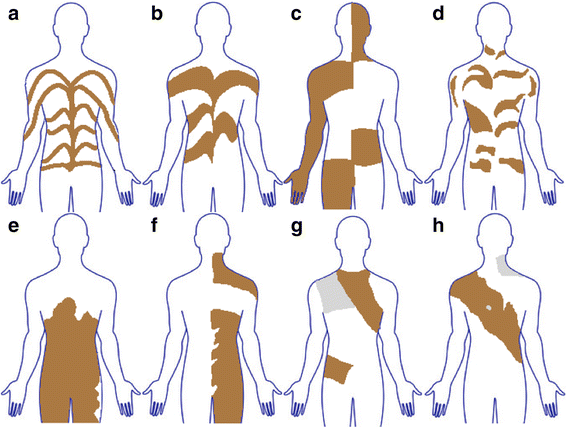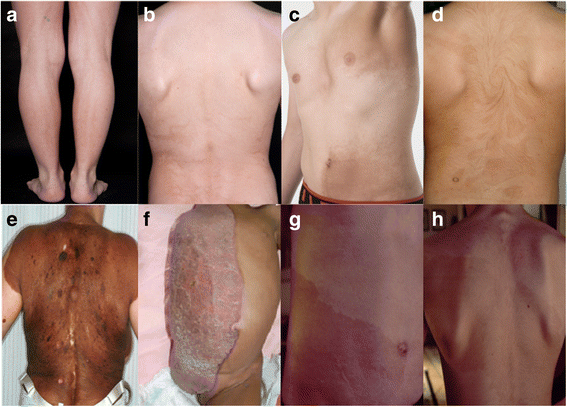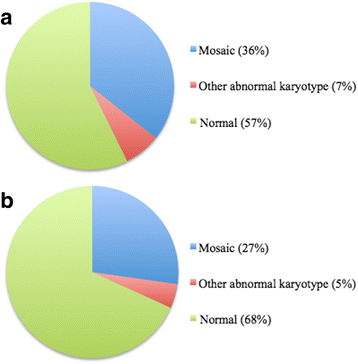Pigmentary mosaicism: a review of original literature and recommendations for future handling
- PMID: 29506540
- PMCID: PMC5839061
- DOI: 10.1186/s13023-018-0778-6
Pigmentary mosaicism: a review of original literature and recommendations for future handling
Abstract
Background: Pigmentary mosaicism is a term that describes varied patterns of pigmentation in the skin caused by genetic heterogeneity of the skin cells. In a substantial number of cases, pigmentary mosaicism is observed alongside extracutaneous abnormalities typically involving the central nervous system and the musculoskeletal system. We have compiled information on previous cases of pigmentary mosaicism aiming to optimize the handling of patients with this condition. Our study is based on a database search in PubMed containing papers written in English, published between January 1985 and April 2017. The search yielded 174 relevant and original articles, detailing a total number of 651 patients.
Results: Forty-three percent of the patients exhibited hyperpigmentation, 50% exhibited hypopigmentation, and 7% exhibited a combination of hyperpigmentation and hypopigmentation. Fifty-six percent exhibited extracutaneous manifestations. The presence of extracutaneous manifestations in each subgroup varied: 32% in patients with hyperpigmentation, 73% in patients with hypopigmentation, and 83% in patients with combined hyperpigmentation and hypopigmentation. Cytogenetic analyses were performed in 40% of the patients: peripheral blood lymphocytes were analysed in 48%, skin fibroblasts in 5%, and both analyses were performed in 40%. In the remaining 7% the analysed cell type was not specified. Forty-two percent of the tested patients exhibited an abnormal karyotype; 84% of those presented a mosaic state and 16% presented a non-mosaic structural or numerical abnormality. In patients with extracutaneous manifestations, 43% of the cytogenetically tested patients exhibited an abnormal karyotype. In patients without extracutaneous manifestations, 32% of the cytogenetically tested patients exhibited an abnormal karyotype.
Conclusion: We recommend a uniform parlance when describing the clinical picture of pigmentary mosaicism. Based on the results found in this review, we recommend that patients with pigmentary mosaicism undergo physical examination, highlighting with Wood's light, and karyotyping from peripheral blood lymphocytes and skin fibroblasts. It is important that both patients with and without extracutaneous manifestations are tested cytogenetically, as the frequency of abnormal karyotype in the two groups seems comparable. According to the results only a minor part of patients, especially those without extracutaneous manifestations, are tested today reflecting a need for change in clinical practice.
Keywords: Blaschko’s lines; Hyperpigmentation; Hypomelanosis of Ito; Hypopigmentation; Linear and whorled nevoid hypermelanosis; Pigmentary mosaicism.
Conflict of interest statement
Ethics approval and consent to participate
Not applicable.
Consent for publication
Not applicable.
Competing interests
The authors declare that they have no competing interests.
Publisher’s Note
Springer Nature remains neutral with regard to jurisdictional claims in published maps and institutional affiliations.
Figures



Similar articles
-
Genetic and clinical characterization of 73 Pigmentary Mosaicism patients: revealing the genetic basis of clinical manifestations.Orphanet J Rare Dis. 2019 Nov 15;14(1):259. doi: 10.1186/s13023-019-1208-0. Orphanet J Rare Dis. 2019. PMID: 31730496 Free PMC article.
-
Linear hypopigmentation and hyperpigmentation, including mosaicism.Semin Cutan Med Surg. 1997 Mar;16(1):44-53. doi: 10.1016/s1085-5629(97)80035-1. Semin Cutan Med Surg. 1997. PMID: 9125765 Review.
-
Linear and whorled hypermelanosis.Pediatr Dermatol. 2007 May-Jun;24(3):205-10. doi: 10.1111/j.1525-1470.2007.00387.x. Pediatr Dermatol. 2007. PMID: 17542865
-
Clinical characteristics of 47 children with pigmentary mosaicism: A cross-sectional study.Ann Dermatol Venereol. 2023 Jun;150(2):109-113. doi: 10.1016/j.annder.2023.01.006. Epub 2023 Mar 27. Ann Dermatol Venereol. 2023. PMID: 36990862
-
Abnormal pigmentation in hypomelanosis of Ito and pigmentary mosaicism: the role of pigmentary genes.Br J Dermatol. 2004 Aug;151(2):269-82. doi: 10.1111/j.1365-2133.2004.06057.x. Br J Dermatol. 2004. PMID: 15327534 Review.
Cited by
-
Monogenic causes of pigmentary mosaicism.Hum Genet. 2022 Nov;141(11):1771-1784. doi: 10.1007/s00439-022-02437-w. Epub 2022 May 3. Hum Genet. 2022. PMID: 35503477
-
Clinical spectrum of MTOR-related hypomelanosis of Ito with neurodevelopmental abnormalities.Genet Med. 2021 Aug;23(8):1484-1491. doi: 10.1038/s41436-021-01161-6. Epub 2021 Apr 8. Genet Med. 2021. PMID: 33833411 Free PMC article.
-
Pigmentary mosaicism as a recurrent clinical manifestation in three new patients with mosaic trisomy 12 diagnosed postnatally: cases report and literature review.BMC Med Genomics. 2022 Oct 31;15(1):224. doi: 10.1186/s12920-022-01382-x. BMC Med Genomics. 2022. PMID: 36316743 Free PMC article. Review.
-
Linear and Whorled Nevoid Hypermelanosis - A Case of Pigmentary Mosaicism.Indian Dermatol Online J. 2023 Oct 5;15(1):82-85. doi: 10.4103/idoj.idoj_9_23. eCollection 2024 Jan-Feb. Indian Dermatol Online J. 2023. PMID: 38283022 Free PMC article.
-
A Case of Mucopolysaccharidosis II Caused by a Novel Variant with Skin Linear Hyperpigmented Streaks along Blaschko's Lines.Int J Mol Sci. 2023 Mar 15;24(6):5647. doi: 10.3390/ijms24065647. Int J Mol Sci. 2023. PMID: 36982718 Free PMC article.
References
-
- Happle R. Mosaicism in human skin. 1. Berlin: Springer; 2014.
Publication types
MeSH terms
LinkOut - more resources
Full Text Sources
Other Literature Sources
Miscellaneous

